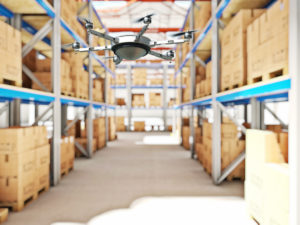Drones are becoming the future of supply chain. While possibilities are discussed, one application being evaluated is using drones inside warehouses for inventory management.
Automation has been adopted into supply chains for decades now. While technologies such as conveyors, sorters, automated storage and retrieval systems (AS/RS), robots, and automated mobile robots (AMR) have made deep inroads, companies are actively working on artificial intelligence (AI) and machine learning (ML) for suitable applications. In recent years, the concept of drones has emerged and started to make waves. They are still in their infancy stage in terms of mass usage, however, they have already broken barriers in multiple industries.
Drones have existed for more than two decades, with their roots dating back to World War I, when both France and The United States developed automatic, unmanned airplanes. The last few years have been significant in terms of drone adoption, usage expansion across industries, and global awareness; from technically manning sensitive military areas, to attracting hobbyists worldwide, drone technology has prospered. Individuals, commercial entities and governments have realised that drones have multiple functions. To date, Indian drone start-ups have demonstrated their ability to detect mosquito breeding grounds to help eradicate blood-borne illnesses, assist city planners in mapping urban environments with cost-effectiveness and precision, and even deliver fast food to local communities in a safe and reliable way.
Drones can be a viable option to replace manual inspections and surveillance operations in warehouses. They can also be used for intralogistics, transporting parts from warehouses to factory assembly lines. There has been a lot of ongoing research in product delivery by multiple companies across the globe, however in this article, the focus will be on the use of drones in warehouse for inventory management, which is gaining momentum every day. The size of warehouses is increasing and the difficulty in attracting skilled labour, increasing demand for customer services, and the rise of e-commerce have intensified the need to further increase efficiency in warehouse operations through the use of automation. This need for automation is supported by constant innovation and upgrades in technologies like scanning, AI, ML, onboard computing power, and more.
Inventory management is the highest potential use case for drones. In the area of inventory management, drones can be used for inventory audit, cycle counting, item search, stock taking etc. In these physical inventory count methods, a person walks or drives to a designated location in the warehouse, scans the barcode of the item and moves on to the next location following their schedule. This counting method is slow, labour-intensive, expensive, repetitive, and dangerous as people must work at heights. Drones can add value to optimize this process.
There are advantages to using drones for inventory management:
- Cycle counts/ inventory audits being more regularly used compared to manual labour due to high speed and productivity. This allows for more frequently updated inventory accuracy, as well as an increased visible trackability of any inventory errors
- When drones are doing autonomous work there is no manual control of the drone, except in emergency cases. Someone with little to no experience of flying a drone can use the automation technology that accompanies the drone to carry out the flight mission. Hence, there is no need of additional Material Handling Equipment (MHE) and allied infrastructure for people to conduct activities such as cycle counting. This also frees up critical MHE for operations
- Pilots will be operating remotely or within visibility of the drone. Therefore, there is no direct activity of people in the working area. This leads to increased safety in the workplace
- While drones are great tools for managing labour effectively, they would not be considered if they were inaccurate. Due to the nature of warehousing and elements of physical manipulations or human error, drone accuracy can be as high as 97% to 99% . The technological capability also helps to analyse inaccuracy such as unreadable labels or unregistered products in the system. These instances may happen often when the technology is initially implemented, but overtime, the longer the system is in place, the more accurate it becomes
Some key challenges of implementing drone technology in warehouses are:
- Incompatible warehouse management systems (WMS): the existing WMS may not accommodate this new technology, or some may have limitations in customisation to give full benefits. Therefore, suitability must be checked before identifying the right drone technology partner
- Labelling accuracy: because of varying box sizes of stock keeping units (SKUs), labels are not uniformly spread in any given racking or shelving bay. There are inconsistencies in pasting those labels to each pallets/box/bin, i.e. they may not always be in the same direction. There might be printing issues or an accumulation of dust on these labels. Such issues can create hinderances when scanning. However, with the latest technologies in scanning, cameras and AI/ML based programmes, these challenges are largely addressed, and the drones need to be taught to read such events and convert them to the desired outcome
- View of inventory: current technology limits our view to pick the face of the pallet/box/bin. Therefore, it only works well for single deep storage
- Disorganised storage: disorganised storage can be a major challenge in deploying drones. If the correct protocol of keeping labels to face drones is not maintained, the drone will not capture SKUs, which will lead to inaccuracies. It has also been observed that due to stacking issues, the boxes may become crumpled, and the labels are partially or completely invisible, reducing the accuracy of scans. If there are boxes protruding too far in the aisle, it may lead to safety issues. Having flight experience may help reduce such instances
- Flying time of drones: current battery technology limits drone flying time. This also means the drone would have to come back for charging after small cycles. This challenge can be addressed by multiple drones deployed in sequence, i.e. when the battery is low, the drone comes back for charging and a second drone flies out to take over the activity. Another alternative is connecting the drone through a cable to the mother autonomous vehicle, which moves on-ground. This arrangement increases drone-deployment time as larger vehicles with batteries are available to support the drone for power. There is also an option for a wireless charging landing pad that the drone knows to fly back to. This allows for another level of autonomy that removes the step of going out and switching dead batteries with a new one
With evolution of technologies and drones becoming smarter, the use case may become a reality in the very near future, and every large warehouse will be seen with drones flying inside.







